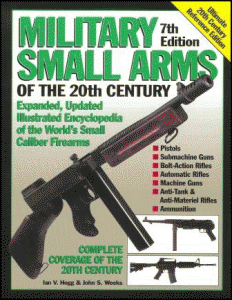 If you’re an avid firearms enthusiast, this is the bible on the subject of military firearms.
If you’re an avid firearms enthusiast, this is the bible on the subject of military firearms.
In publication since 1973, this huge reference book, written by renowned weapons expert Ian V. Hogg and John S. Weeks, chronicles firearms development from 1900 -2000. It technically covers the late 1800s as well, since many of the 20th century’s famous guns were designed in the 1890s.
The 7th and final edition of “Military Small Arms†is a large soft cover book that is lightweight for a book of its size. It is 416 pages long and covers five types of firearms — pistols, sub-machine guns, bolt action rifles, automatic rifles, machine guns and anti-tank riles/anti-material rifles.
It also has chapters on the principle of operation for various fire arms (i.e. what gas operated is, what delayed blowback is etc.), in addition to chapters on ammunition with a data table and an introductory chapter for each type of firearm covered.
The book has a lot going for it. It not only covers all the major firearms producing countries (France, Germany, Russia, the UK and US), but many smaller nations such as Belgium, Finland and the former Czechoslovakia. Because of that, you can find some very interesting and odd ball weapons in this book.
Everything from the Canadian Ross and the US Navy Lee straight pull rifles, Japan’s Type-2 Paratroop rifle that breaks down into halves and Mexico’s early automatic rifle the Mondragon, to the USSR’s Stechkin machine pistol and the Nazi’s Sten gun clone are addressed here. It also covers antitank rifles, which many people aren’t familiar with at all, along with their modern descents the anti-material rifles.
As usual, Hogg does a fantastic job summing up the UK sections of his book. The number of Lee Enfield rifle and Webley pistol variants can drive you mad and he neatly organizes what can be a bewildering topic.
His coverage on German and American firearms is also superb. Displaying an affinity toward the designs of Browning and Mauser, he tends to go into much more detail on these weapons.
Captioning was an issue in some of the earlier editions and while that’s improved, several weapons are misidentified in the captions.
The coverage of some countries isn’t so in depth and smacks of bias. While the entries for Russian/Soviet, Japanese and Italian guns are technically accurate, they often contain snubs and snarky comments.
The entry on Soviet snipers rifles is incorrect and lacking and his coverage on Japanese machine guns and pistols is seems just plain biased.
He often cites them as being unpopular with Japanese troops without even citing a reference.
Firsthand accounts of Japanese infantrymen being unhappy with their country’s machine guns are practically unheard of, if not presently nonexistent.
He states that the Type-2 paratroop rifle was “not a success,†which is hard to prove being that it was never used in an airborne operation. While he praises Soviet firearms for their utility, he seems to hint at a lack of innovation in their design, calling the SKS “uninspired,†for instance.
The issue of bias aside, “Military Small Arms†of the 20th Century is still the best general reference on the subject around. It’s cheap (around $25 new), very readable and easily located.
While some information should have been updated as it became available over time, it is far more useful than it is inaccurate.
So if you’re new to the subject or require a large handy reference this book, this makes an invaluable part of your library.

I was skimming the reviews on Review Fix and I knew you were the author of this piece! lol